Electrical Characteristics of Ultrasonic Piezoelectric Devices Using Pb0.88 (La0.6 Sm0.4)0.08 (Mn1/3 Sb2/3)0.02 Ti0.98 O3 Ceramics for Alleviating Temporomandibular Joint Disorder Pain
Abstract
1. Introduction
2. Experimental Section
3. Results and Discussion
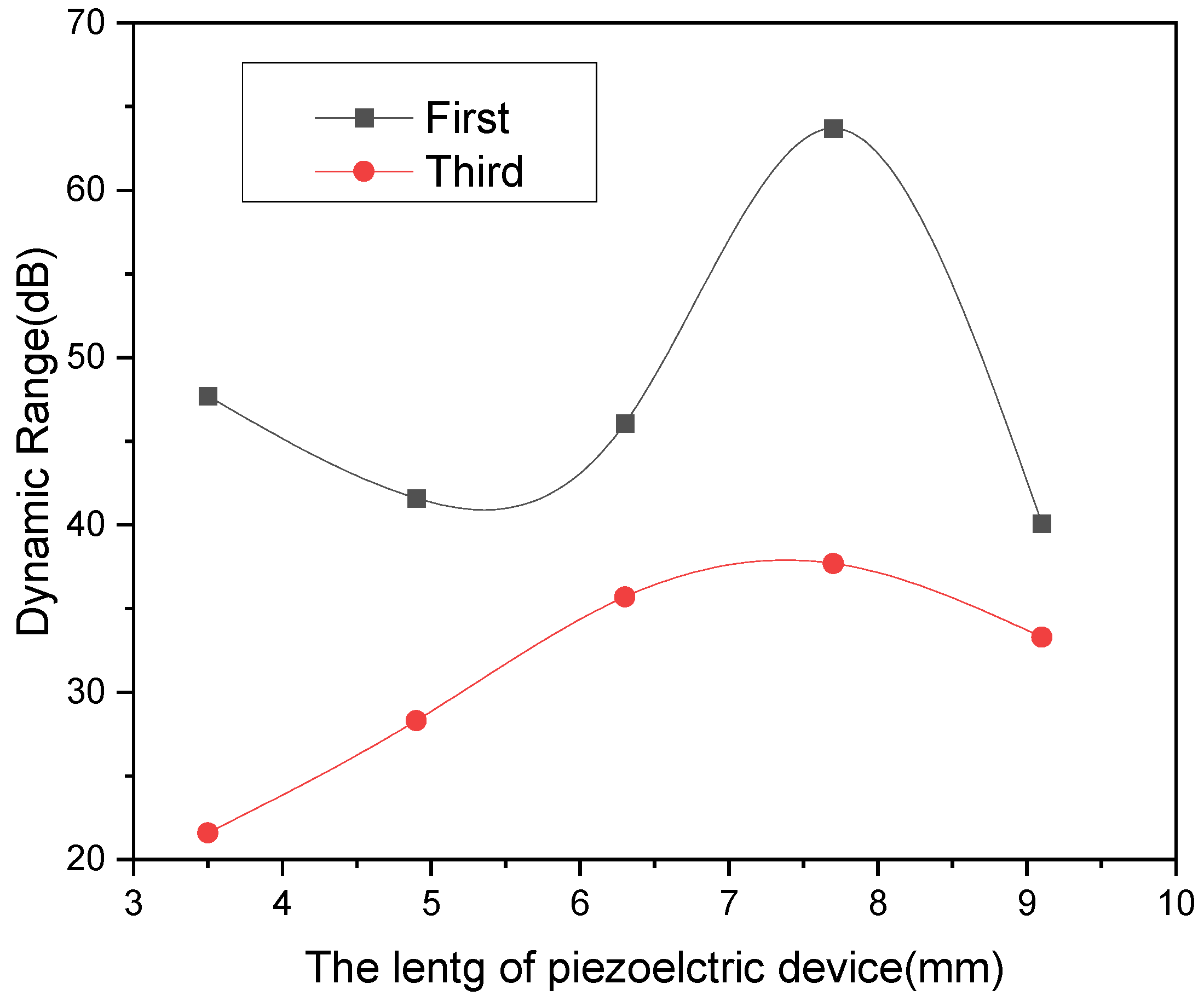
4. Conclusions
- The specimens sintered at 1200 °C and 1230 °C exhibited pure perovskite phase, and few secondary phases were observed.
- For the specimens sintered at 1200 °C, the dielectric constant (εr) of 202, piezoelectric constant (d33) of 56 pC/N, first and third overtone electromechanical coupling factors kt 1 of 0.548 and kt3 of 0.219, and first and third overtone mechanical quality factors Qmt1 of 345 and Qmt3 of 292 were suitable for the device application as an ultrasonic transducer, respectively.
- When the side length of the piezoelectric device was 7.7 mm, the first and third overtone electromechanical coupling factors kt of 0.555 and kt3 of 0.196, first and third overtone mechanical quality factors Qm of 381 and Qmt3 of 393, and first and third overtone dynamic ratios (D.Rs) of 63.7 and 37.7 dB were suitable for the device applications as an ultrasonic transducer for temporomandibular joint disorder pain relief and facial skin massage, respectively.
- Finally, it is considered that the first vibration mode near 3 MHz was very suitable for device application as an ultrasonic transducer for alleviating temporomandibular joint disorder. In particular, the third vibration mode at 9.8 MHz can be utilized for device application as an ultrasonic transducer for an ultrasonic facial massager. Accordingly, the fabricated piezoelectric device can be simultaneously utilized as 3 MHz and 9.8 MHz ultrasonic generating devices.
Author Contributions
Funding
Data Availability Statement
Conflicts of Interest
References
- Kim, C. Conservative treatment modalities for patients with temporomandibular joint (TMJ) disorders. J. Korean Dent. Assoc. 2013, 51, 74–83. [Google Scholar]
- Lee, Y.S.; Byun, Y.S.; Choi, J.H.; Ahn, H.J. Evaluation of masticatory efficiency and oral health related quality of life in temporomandibular disorder patients. J. Oral Med. Pain 2010, 35, 135–147. [Google Scholar]
- Kim, D.K.; Lim, H.D.; Lee, Y.M. Evaluation of quality of life according to temporomandibular disorder symptoms in dental hospital worker. J. Oral Med. Pain 2012, 37, 61–72. [Google Scholar] [CrossRef]
- Shim, Y.J. Diagnosis and treatment of acute temporomandibular disorders. J. Korean Dent. Assoc. 2020, 58, 354–363. [Google Scholar]
- Ba, S.; Zhou, P.; Yu, M. Ultrasound is Effective to Treat Temporomandibular Joint Disorder. J. Pain Res. 2021, 14, 1667. [Google Scholar] [CrossRef] [PubMed]
- Shanks, P.; Curran, M.; Fletcher, P.; Thompson, R. The effectiveness of therapeutic ultrasound for musculoskeletal conditions of the lower limb: A literature review. Foot 2010, 20, 133–139. [Google Scholar] [CrossRef] [PubMed]
- Yoo, S.H.; Choi, W.J.; Lee, S.W. A Study on the Actual Output and Thermal Effect in Tissue Mimicking Phantom by the Material of the Ultrasonic Transducer. J. Korean Soc. Phys. Med. 2015, 10, 91–97. [Google Scholar] [CrossRef][Green Version]
- Yoo, J.; Oh, D. Electrical and resonant characteristics of modified PbTiO3 ceramics for SMD-type high frequency resonators using 3rd over thickness vibration mode. Sens. Actuators A Phys. 2003, 105, 55–61. [Google Scholar] [CrossRef]
- Kim, H.J.; Kim, M.H. The Effects of Kettlebell Exercise and Ultrasound Treatment on Body Mass Index and Percent Body Fat in 20’s Adults. J. Korean Phys. Ther. Sci. 2018, 25, 1–6. [Google Scholar] [CrossRef]
- Qiao, L.; Li, G.; Tao, H. Full characterization for material constants of a promising KNN-based lead-free piezoelectric ceramic. Ceram. Int. 2020, 46, 5641–5644. [Google Scholar] [CrossRef]
- Jia, H.; Mi, J.; Li, Z.; Wang, L. Improved dielectric and piezoelectric properties of Sm-doped PMN-PZN-PT ternary. Ceram. Int. 2022, 48, 14761–14766. [Google Scholar] [CrossRef]
- Zhou, C.; Zhang, J.; Yao, W.; Liu, D.; He, G. Remarkably strong piezoelectricity, rhombohedral-orthorhombic-tetragonal phase coexistence and domain structure of (K, Na)(Nb, Sb)O3–(Bi, Na)ZrO3–BaZrO3 ceramics. J. Alloys Compd. 2020, 820, 153411. [Google Scholar] [CrossRef]
- Zhang, B.; Wu, J.; Cheng, X.; Wang, X.; Xiao, D.; Zhu, J.; Wang, X.; Lou, X. Lead-free Piezoelectrics Based on Potassium-Sodium Niobate with Giant d33. ACS Appl. Mater. Interfaces 2013, 5, 7718–7725. [Google Scholar] [CrossRef] [PubMed]
- Dong, Y.; Yue, Q.; Cheng, D.; Zhou, Z.; Liang, R.; Dong, X. Ultrasonic transducer with BiScO3-PbTiO3-based ceramics of operating temperature over 400 °C IRE standards on piezoelectric crystals: Measurement of piezoelectric ceramics. Sens. Actuators 2022, 340, 113528. [Google Scholar] [CrossRef]
- Park, J.; Je, Y.; Lee, H.; Moon, W. Design of an ultrasonic sensor for measuring distance and detecting obstacles. Ultrasonics 2010, 50, 340–346. [Google Scholar] [CrossRef] [PubMed]
- Yoo, J.; Min, S.; Park, C.; Suh, S.; Yoon, H.; Kim, J.; Lee, S. Electrical properties of (Pb, La, Nd)(Mn, Sb, Ti)O3 ceramics for 20 MHz resonators. Jpn. J. Appl. Phys. 2002, 41, 701. [Google Scholar] [CrossRef]
- Seiji, I.; Ichiro, U.; Takahashi, N. Electromechanical properties of PbTiO3 Ceramics containing La and Ma. J. Acoust. Soc. Am. 1971, 50, 1060–1066. [Google Scholar]
- Lee, S.-H.; Yoo, J.-H.; Yoon, H.S. Thickness vibration mode piezoelectric transformer for power converter. Trans. Electr. Electron. Mater. 2000, 1, 1–5. [Google Scholar]
- Yoo, J. High Dielectric and Piezoelectric Properties of Low-Temperature Sintering PNN-PMN-PZT Ceramics for Low-Loss Piezoelectric Actuator Application. Trans. Electr. Electron. Mater. 2018, 19, 249–253. [Google Scholar] [CrossRef]
- Jeong, Y.; Yoo, K.; Yoo, J. Piezoelectric and dielectric characteristics of low-temperature-sintering Pb(Mg1/2W1/2)O3–Pb(Ni1/3Nb2/3)O3–Pb(Zr, Ti)O3 ceramics according to the amount of PNN substitution. J. Electroceramics 2009, 23, 387–391. [Google Scholar] [CrossRef]
- Lee, K.S.; Lee, I.H.; Yoo, J.H.; Ryu, S.L. Piezoelectric and Dielectric Properties of PZW-PMN-PZT Piezoelectric Ceramic according to Sintering Aid Li2CO3 Addition. J. Korean Inst. Electr. Electron. Mater. Eng. 2007, 20, 1034–1038. [Google Scholar]
- Yoo, J.; Lee, J. The Effects of MnO2 Addition on the Physical Properties of Pb(Ni1/3Nb2/3)O3-Pb(Zr, Ti)O3-Pb(Mg1/2W1/2)O3-BiFeO3 Ceramics. Crystal 2021, 11, 269. [Google Scholar] [CrossRef]
- Yoo, J.; Lee, J.; Kang, S.; Eum, M.; Lee, S.; Kee, S.H. Microstructure and Piezoelectric Properties of Pb(Ni1/3Nb2/3)O3-Pb(Zr, Ti)O3 System Ceramics doped with Sb2O5 for Ultrasonic Nondestructive Testing Transducer. Trans. Electr. Electron. Mater. 2023, 24, 163–168. [Google Scholar] [CrossRef]
- Iula, A.; Parenti, L.; Fabrizi, F.; Pappalardo, M. A high displacement ultrasonic actuator based on a flexural mechanical amplifier. Sens. Actuators A Phys. 2006, 125, 118–123. [Google Scholar] [CrossRef]
- Stamatellou, A.M. PZT and PVDF piezoelectric transducers’ design implications on their efficiency and energy harvesting potential. Energy Harvest. Syst. 2023, 10, 157–167. [Google Scholar] [CrossRef]
- Jaffe, B.; Cook, W.R.; Jaffe, H. Piezoelectric Ceramics; Academic Press: Cambridge, MA, USA, 1971; Volume 154–159, pp. 121–123. [Google Scholar]
- Kang, S.; Lee, J.; Yoo, J.; Whang, S.A.; Lee, S.; Kee, S.; Im, I.; Oh, C. High-Performance Piezoelectric Characteristics of Sm Substituted Pb(Ni, Nb)O3-Pb(Zr, Ti)O3-Pb(Mg, W)O3 System Ceramics for Ultrasonic Transducer Application. Crystals 2022, 12, 738. [Google Scholar] [CrossRef]

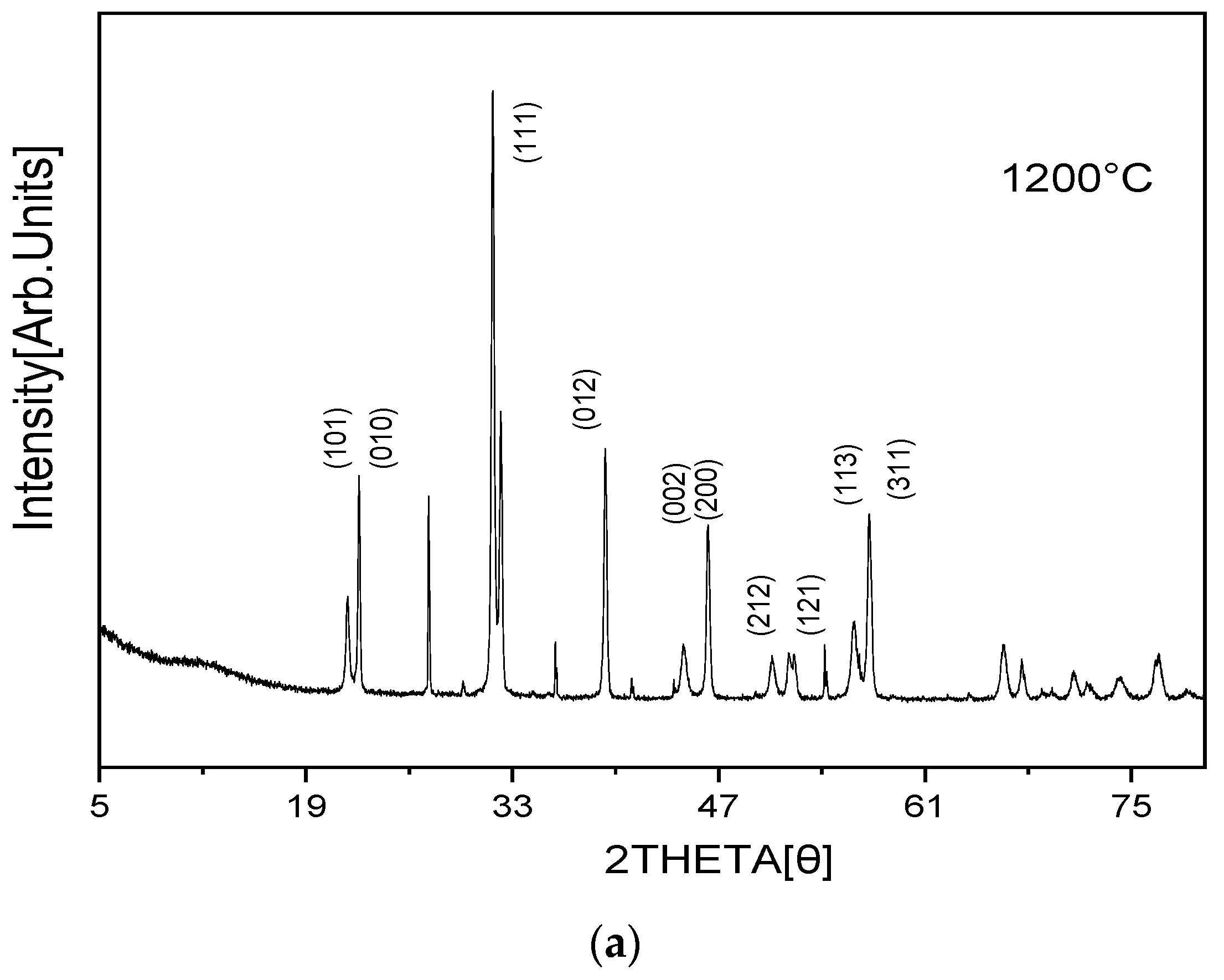

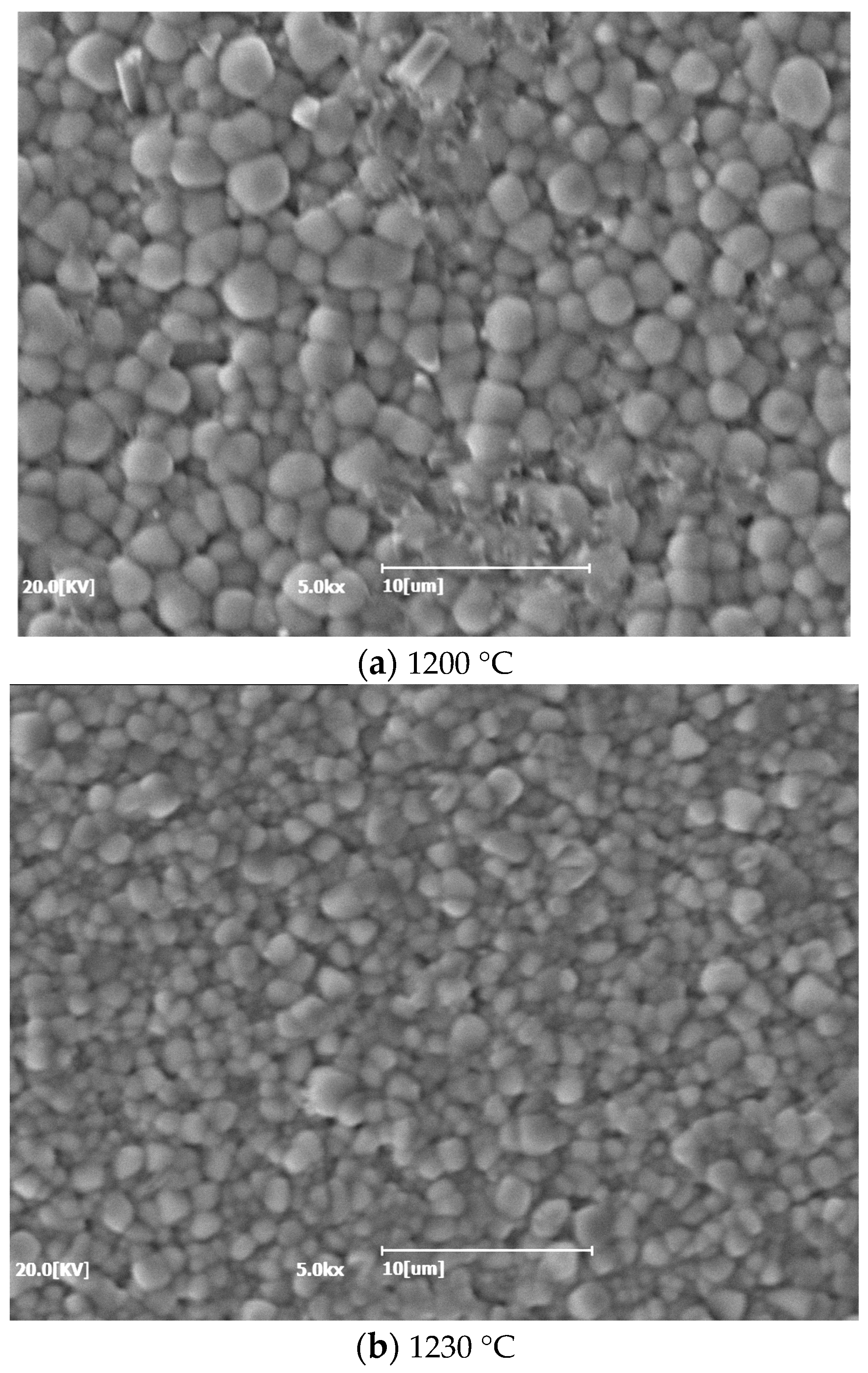

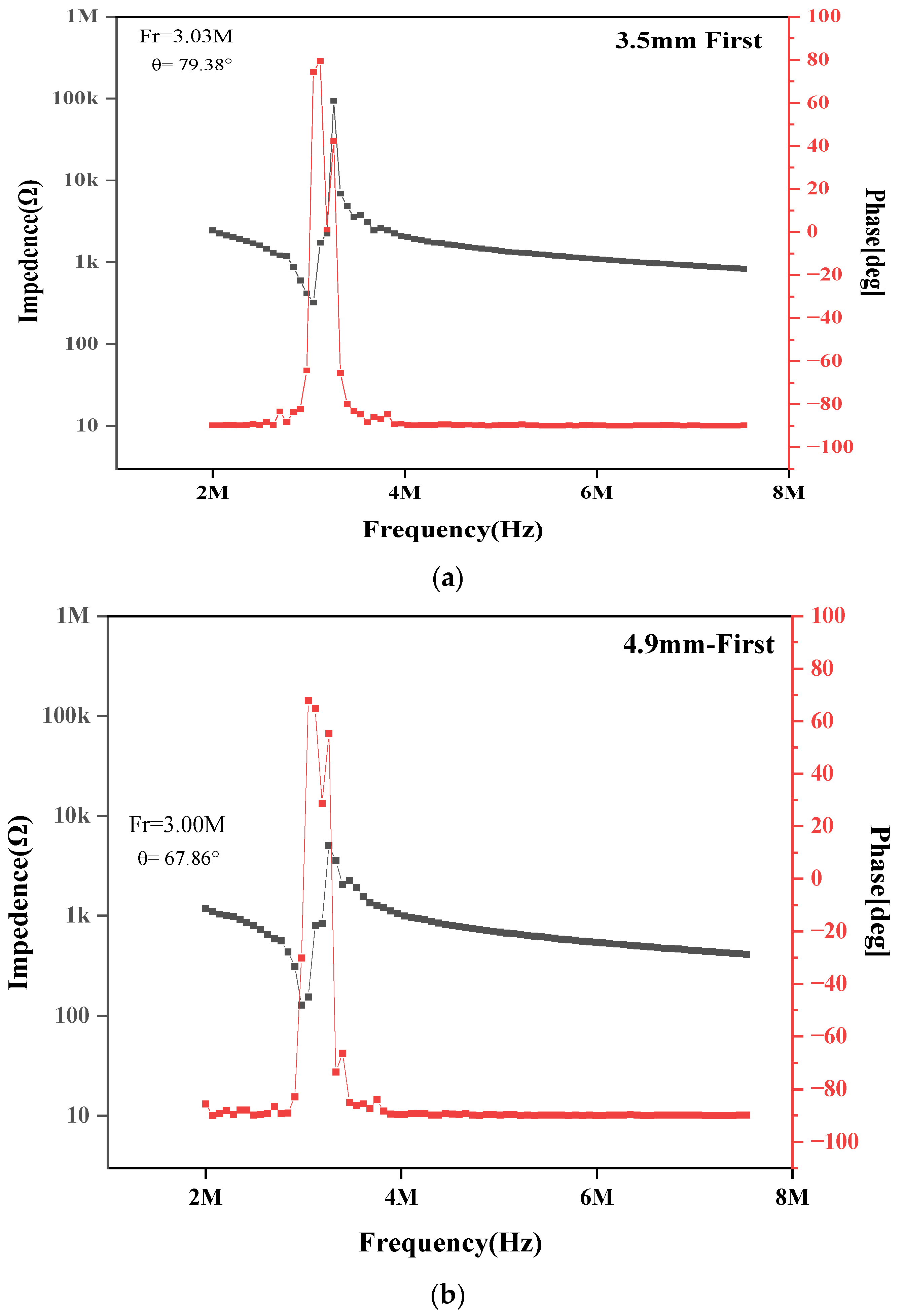
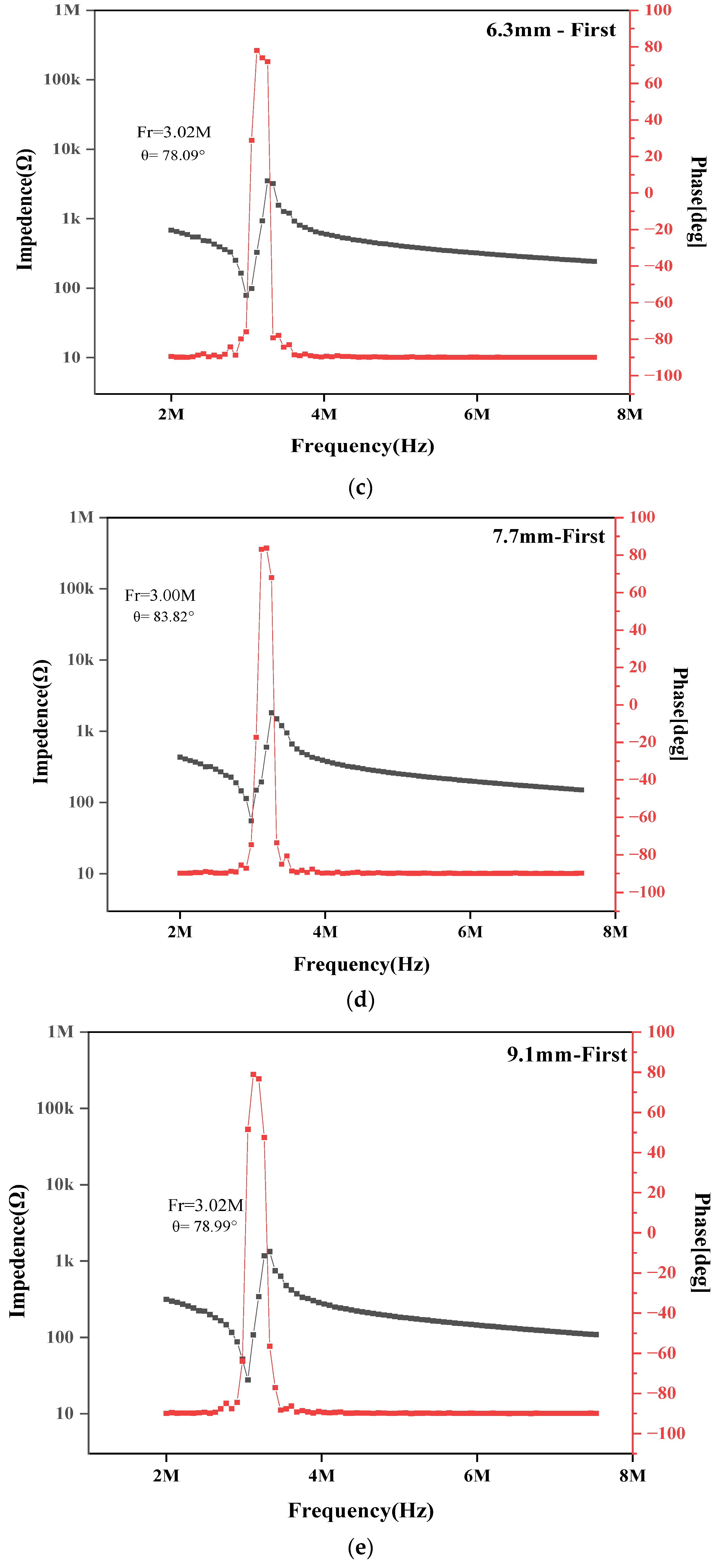
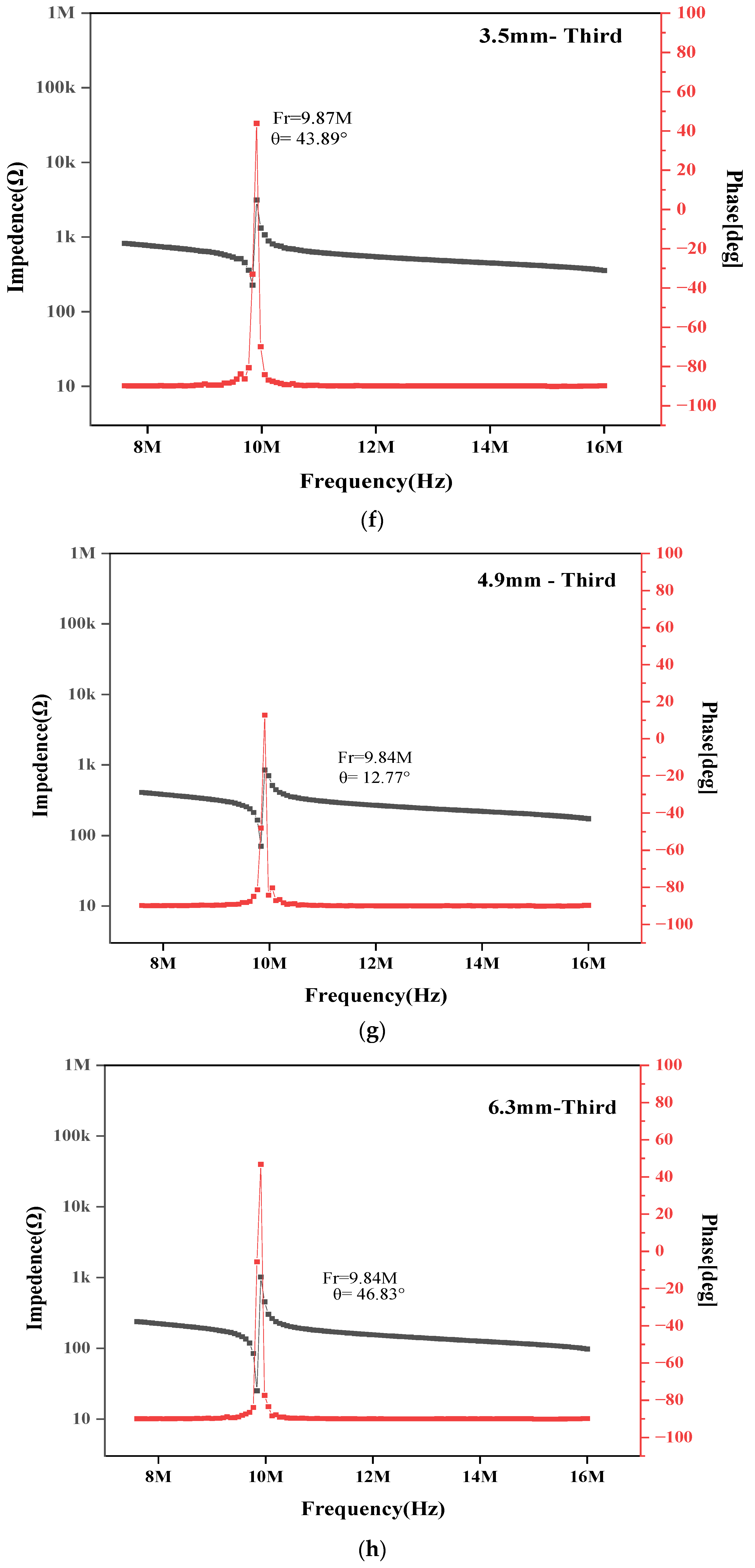
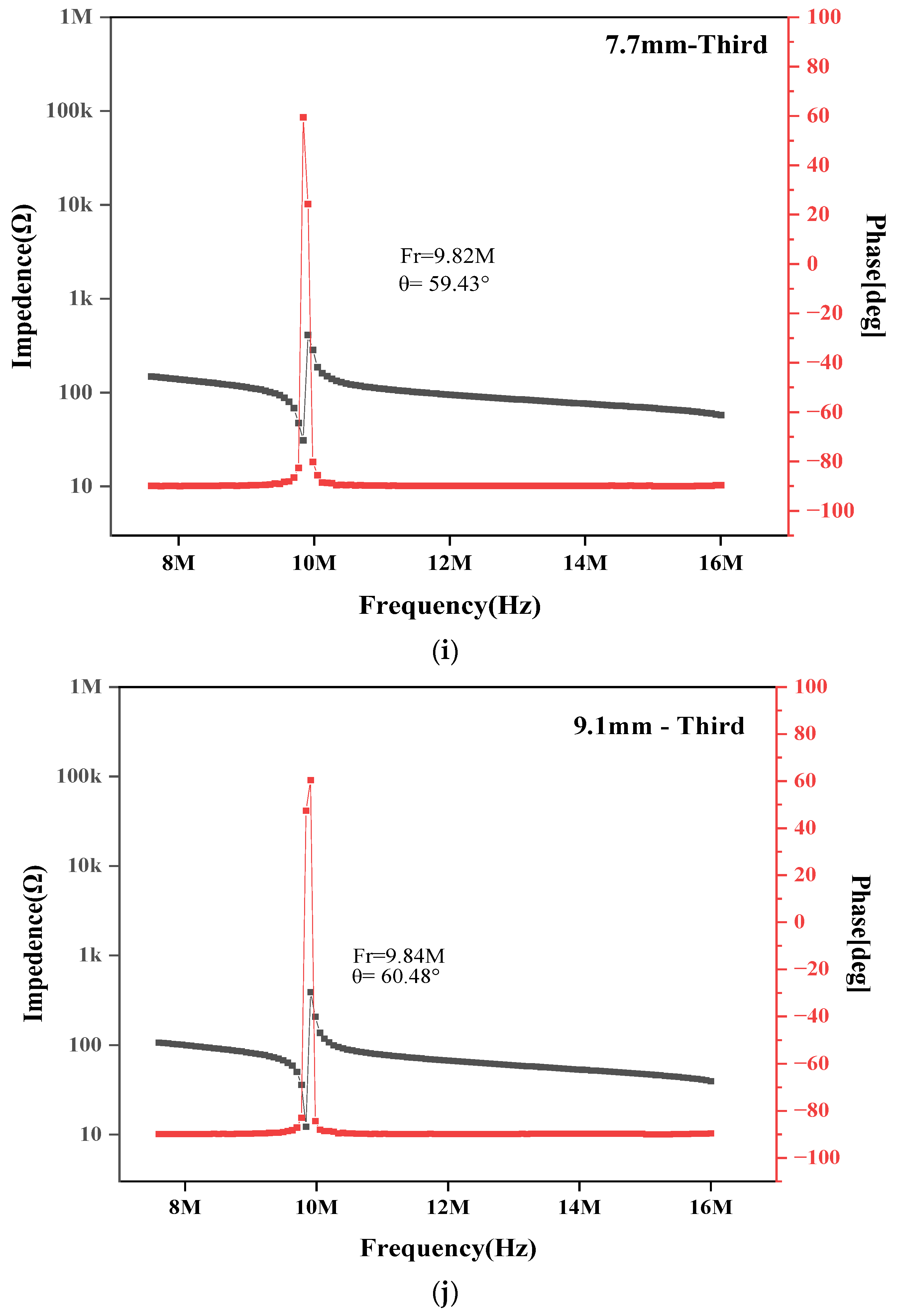
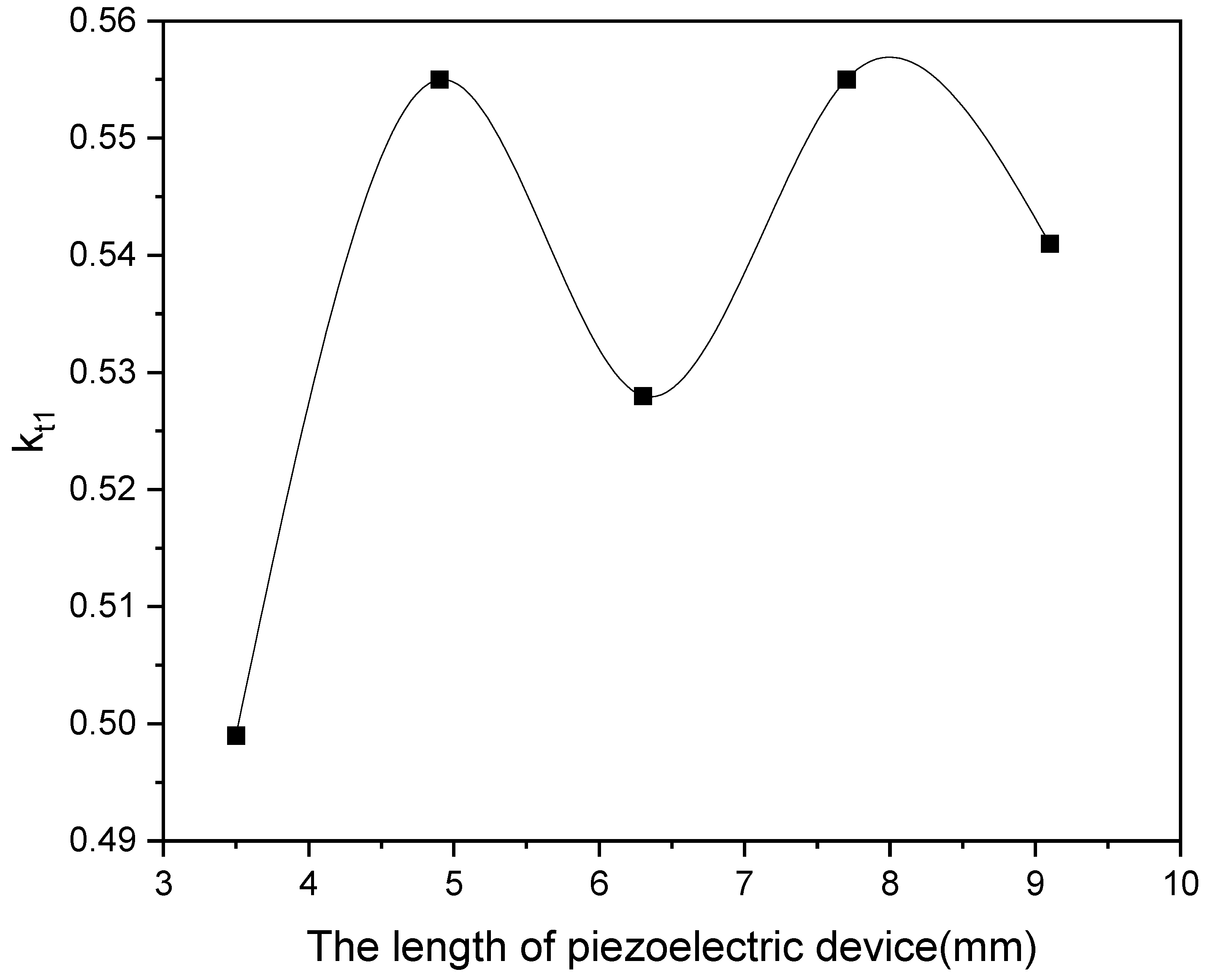
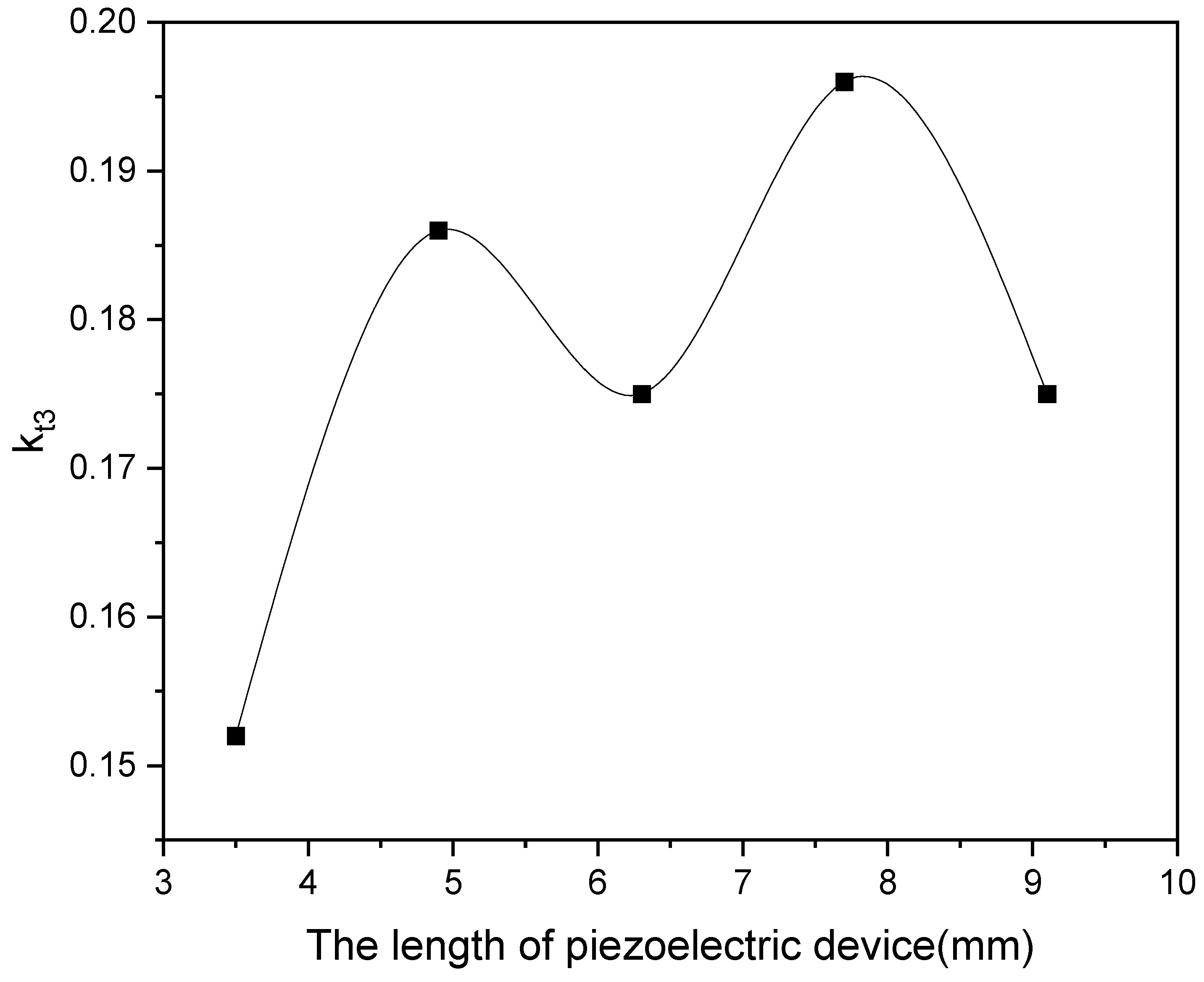
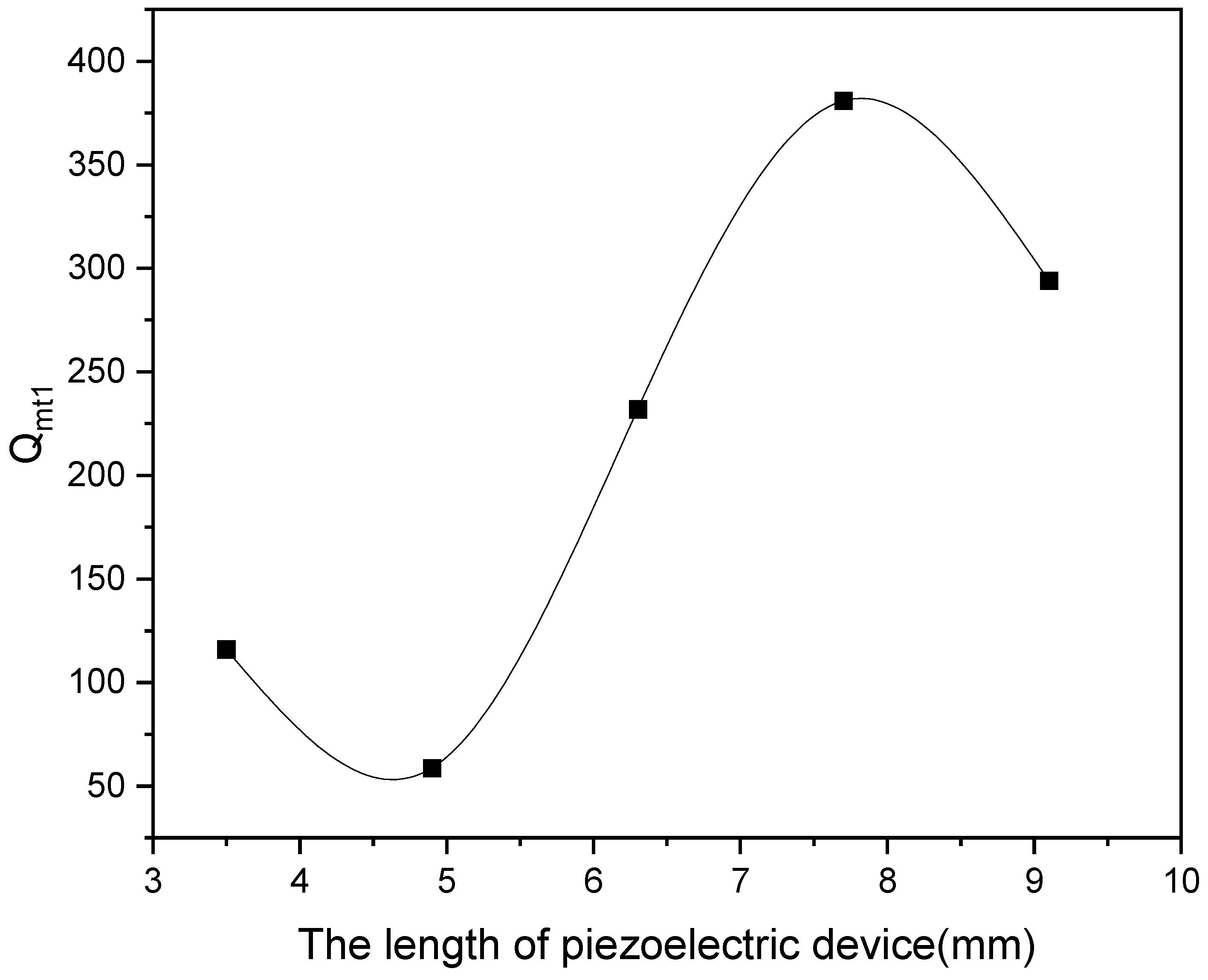
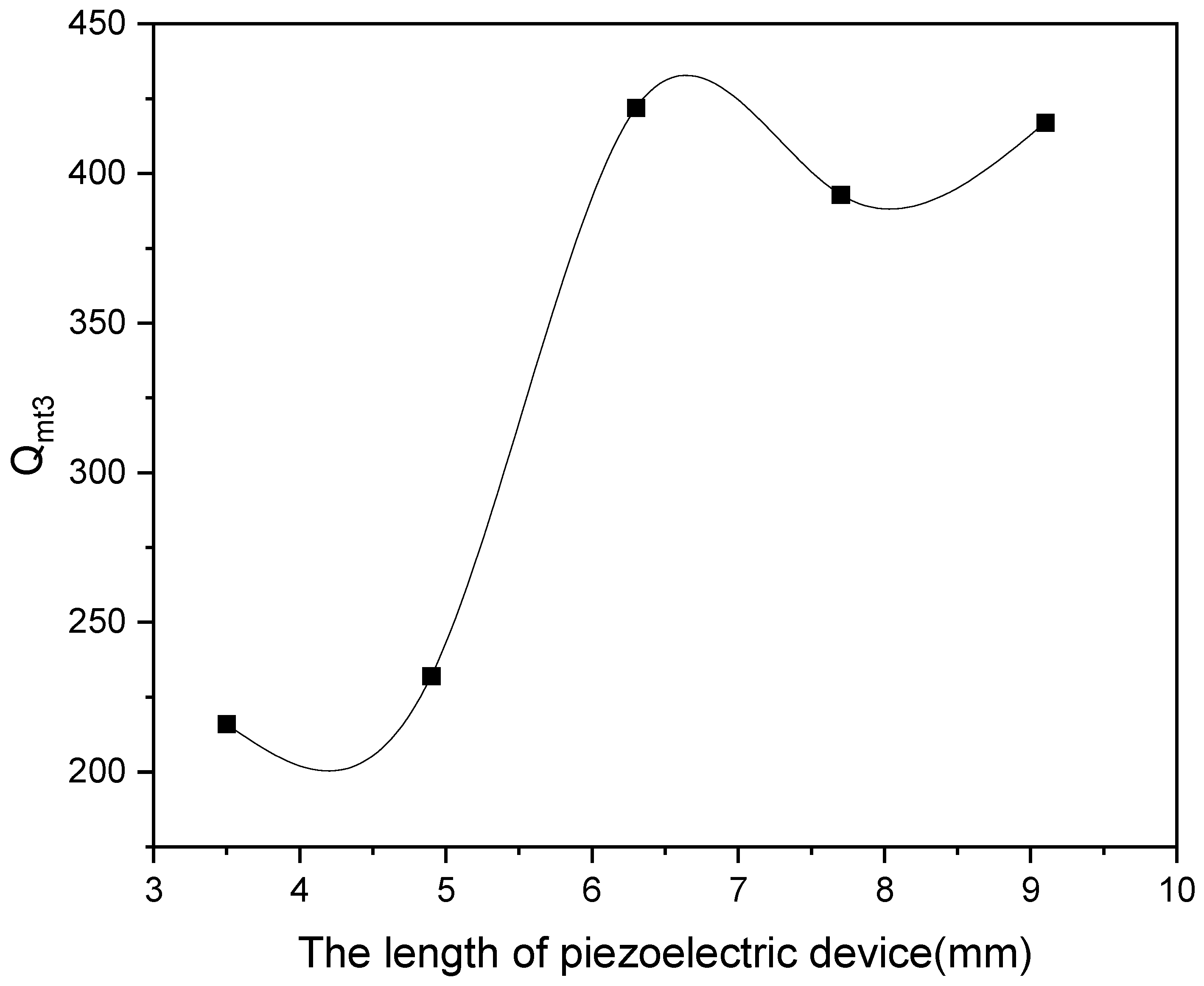
| Sintering Temp.(°C) | Density [g/cm3] | Vibration Mode | fr (MHz) | Fa (MHz) | Zr (Ω) | Za (Ω) | kt | Dielectric Constant | Qmt | D.R. (dB) |
|---|---|---|---|---|---|---|---|---|---|---|
| 1200 | 7.8 | First | 3.035 | 3.315 | 2.18 | 11,060 | 0.5486 | 202 | 345 | 74.1 |
| Third | 9.830 | 9.955 | 5.16 | 419 | 0.219 | 292 | 38.19 | |||
| 1230 | 7.72 | First | 3.090 | 3.370 | 7.749 | 2943 | 0.544 | 229 | 94.3 | 51.59 |
| Third | 9.850 | 10.090 | 11.452 | 99.3 | 0.299 | 67.8 | 18.76 |
| The Side Length of Piezoelectric Device (mm) | Vibration Mode | fr (MHz) | Fa (MHz) | Zr (Ω) | Za (Ω) | kt | Qmt | D.R (dB) |
|---|---|---|---|---|---|---|---|---|
| 3.5 | First | 3.035 | 3.260 | 105.79 | 25,835 | 0.499 | 116 | 47.7 |
| Third | 9.875 | 9.935 | 199.72 | 2425 | 0.152 | 210 | 21.6 | |
| 4.9 | First | 3.005 | 3.290 | 80.66 | 9712 | 0.555 | 58.7 | 41.6 |
| Third | 9.845 | 9.935 | 57.30 | 1500 | 0.186 | 232 | 28.3 | |
| 6.3 | First | 3.020 | 3.275 | 13.44 | 2705 | 0.528 | 276 | 46.07 |
| Third | 9.840 | 9.920 | 25.19 | 1545 | 0.175 | 422 | 35.7 | |
| 7.7 | First | 3.005 | 3.290 | 4.95 | 7603 | 0.555 | 381 | 63.7 |
| Third | 9.820 | 9.920 | 12.145 | 941 | 0.196 | 393 | 37.7 | |
| 9.1 | First | 3.020 | 3.290 | 5.89 | 600 | 0.541 | 294 | 40.1 |
| Third | 9.840 | 9.920 | 12.49 | 584 | 0.175 | 417 | 33.3 |
Disclaimer/Publisher’s Note: The statements, opinions and data contained in all publications are solely those of the individual author(s) and contributor(s) and not of MDPI and/or the editor(s). MDPI and/or the editor(s) disclaim responsibility for any injury to people or property resulting from any ideas, methods, instructions or products referred to in the content. |
© 2024 by the authors. Licensee MDPI, Basel, Switzerland. This article is an open access article distributed under the terms and conditions of the Creative Commons Attribution (CC BY) license (https://creativecommons.org/licenses/by/4.0/).
Share and Cite
Yoo, J.; Whang, S.A. Electrical Characteristics of Ultrasonic Piezoelectric Devices Using Pb0.88 (La0.6 Sm0.4)0.08 (Mn1/3 Sb2/3)0.02 Ti0.98 O3 Ceramics for Alleviating Temporomandibular Joint Disorder Pain. Appl. Sci. 2024, 14, 6522. https://doi.org/10.3390/app14156522
Yoo J, Whang SA. Electrical Characteristics of Ultrasonic Piezoelectric Devices Using Pb0.88 (La0.6 Sm0.4)0.08 (Mn1/3 Sb2/3)0.02 Ti0.98 O3 Ceramics for Alleviating Temporomandibular Joint Disorder Pain. Applied Sciences. 2024; 14(15):6522. https://doi.org/10.3390/app14156522
Chicago/Turabian StyleYoo, Juhyun, and Sun A Whang. 2024. "Electrical Characteristics of Ultrasonic Piezoelectric Devices Using Pb0.88 (La0.6 Sm0.4)0.08 (Mn1/3 Sb2/3)0.02 Ti0.98 O3 Ceramics for Alleviating Temporomandibular Joint Disorder Pain" Applied Sciences 14, no. 15: 6522. https://doi.org/10.3390/app14156522
APA StyleYoo, J., & Whang, S. A. (2024). Electrical Characteristics of Ultrasonic Piezoelectric Devices Using Pb0.88 (La0.6 Sm0.4)0.08 (Mn1/3 Sb2/3)0.02 Ti0.98 O3 Ceramics for Alleviating Temporomandibular Joint Disorder Pain. Applied Sciences, 14(15), 6522. https://doi.org/10.3390/app14156522








